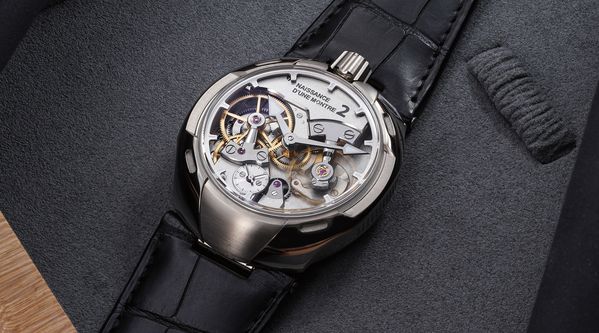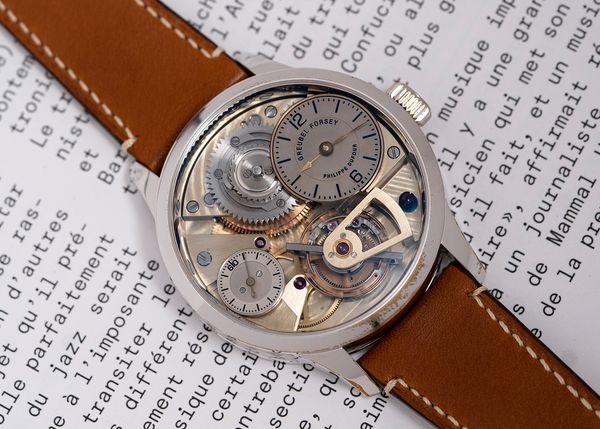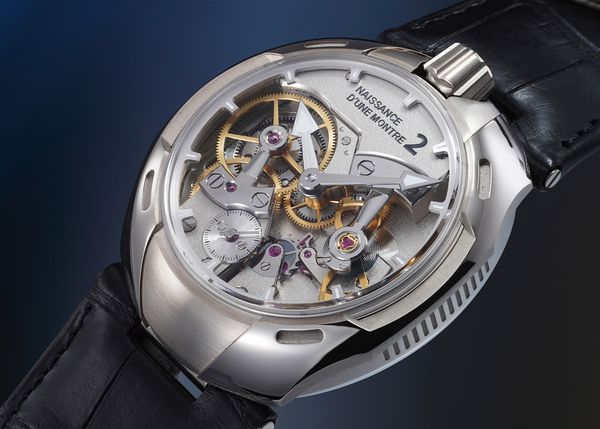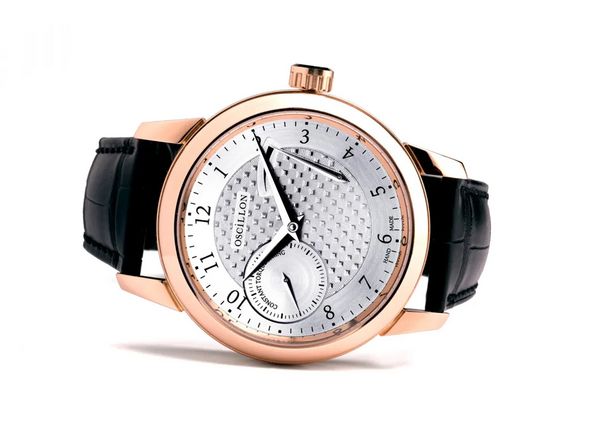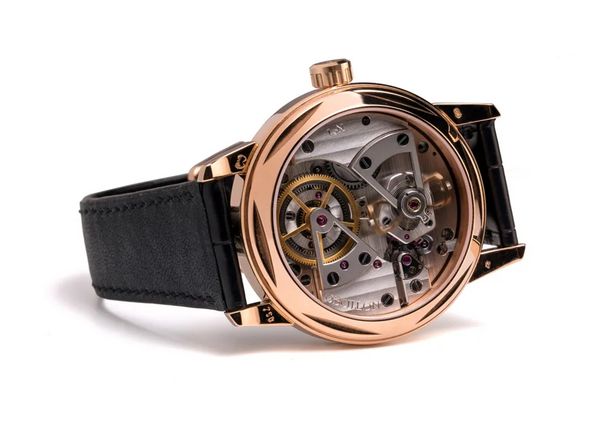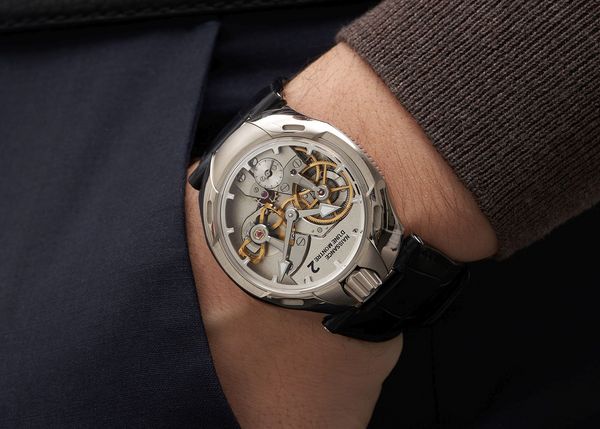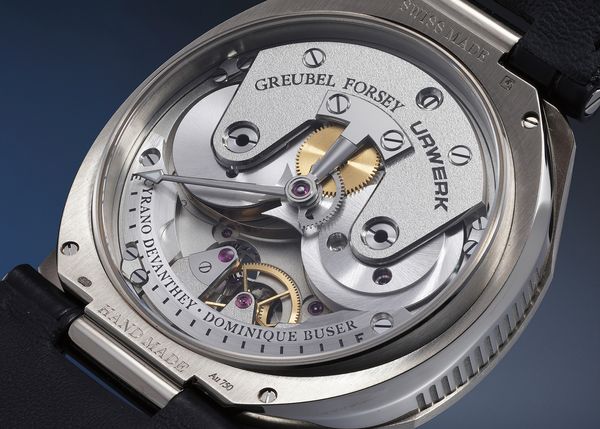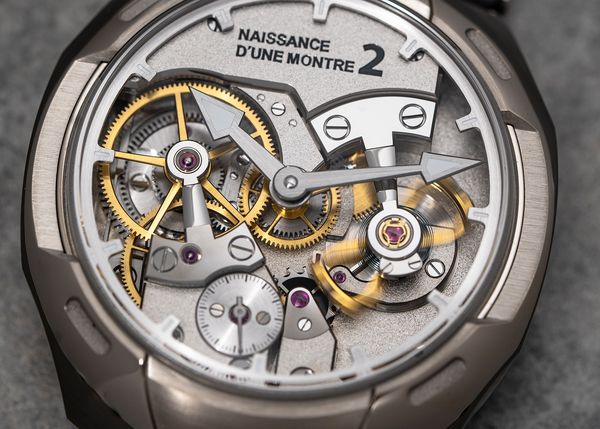Phillips in Association with Bacs & Russo is proud to present a two-part documentary series on the Naissance d'une Montre 2 project, hosted by Arthur Touchot and Logan Baker. The Naissance d'une Montre 2 is a unique and completely handmade watch developed and created by Greubel Forsey, Urwerk, and Cyrano Devanthey and Dominique Buser of Oscillon. You can view part one of the documentary here. The watch will be auctioned off during The Geneva Watch Auction: XVII, on May 13 and 14, 2023.
– By Logan Baker
What does it mean to “birth a watch”?
It’s a complex question, one that the Time Aeon Foundation has been asking for more than a decade now. How can the long tradition of handcraft in mechanical watchmaking be preserved in our current era of high-tech abbreviations (think CNC, CAD, and AI)? Will watchmakers in 20 or 30 years continue to work on lathes and rose engines when they can simply press a button and have a robot execute every aspect with inhuman detail and precision?
The Naissance d’une Montre project – AKA, “the birth of a watch” – was inaugurated by the Time Aeon Foundation as a shot across the bow toward further automation. The goal behind Naissance d’une Montre was to bring together a pair of master Swiss watchmakers who would then take a young watchmaker (or two) under their wing and educate them on every element that goes in to developing a watch by hand.
It’s now been more than a decade since the first Naissance d’une Montre wristwatch was announced. It involved Greubel Forsey and Philippe Dufour teaming up with a young French watchmaker named Michel Boulanger to create a small series of 12 watches that were entirely crafted, built, and assembled by hand. A prototype of Naissance d’Une Montre 1 sold at auction in May 2016 for more than one million Swiss francs, with all proceeds going back to the Time Aeon Foundation.
It was relatively quiet for a number of years after that, until a sequel to Naissance d’une Montre was officially announced in January 2019 at the former SIHH fair in Geneva. And now, more than four years after its announcement, Naissance d’une Montre 2 has been completed and will be sold to the highest bidder as part of The Geneva Watch Auction: XVII, on May 13 and 14, 2023, with all proceeds going to the Time Aeon Foundation. And unlike Naissance d'une Montre 1, which consisted of a run of 12 total watches, only the single unique piece seen here will ever be made of the Naissance d'une Montre 2.
There are a few new faces this time around. Greubel Forsey is now joined by Urwerk, with the two brands acting as mentors to Cyrano Devanthey and Dominique Buser, the duo behind Oscillon, a small watchmaking firm located in Buchs, Switzerland, near Solothurn. Now, at this point, I should refer you back to Part One of this two-part feature, where Arthur Touchot introduced all the individuals in this story and the role that they played in the development and completion of Naissance d’une Montre 2, because the focus of the rest of this article will be almost entirely on the watch itself.
The Naissance d’une Montre 2 is not only a triumph of traditional handcrafted Swiss watchmaking but also a technical tour de force, featuring an unusual, impressive, and proprietary approach for the winding mechanism and the balance wheel.
The path for Devanthey and Buser to get to this point has been long and fraught. The pair met in the early 1990s during watchmaking school in Solothurn, where they became fast friends and bonded over their shared interest in antique tooling and machinery (Felix Baumgartner of Urwerk was in the graduating class one year below Devanthey and Buser). The two went their separate ways after graduating from school but they stayed in touch in order to continue to share their love for vintage manual-operated instruments.
Eventually, in 2005, Baumgartner reached out to Buser for help in completing the construction of the Opus V project that Urwerk was working on at the time with Harry Winston. Buser ended up staying on with Urwerk as an engineer after the Opus V was finished, and when the workload eventually became too much, Buser and Baumgartner called Devanthey to join the team at Urwerk.
Now reunited, Buser and Devanthey's long friendship eventually evolved into a new business venture. The pair founded Oscillon in 2012 based around the principle of manufacturing wristwatches using only traditional machines. The idea sprang from their existing love and their shared collection of antique machines, as well as a drunken conversation between the two during watchmaking school on whether or not assembling a watch the traditional way was still possible. Buser and Devanthey continued to work for Urwerk as the company’s primary engineers, but they began spending their remaining time developing highly complex, hand-built timepieces under the Oscillon banner.
“We are not against CNC machines,” Devanthey says. “We love the possibility of CNC machines, we use them every day when we do the engineering for Urwerk. But Oscillon is about traditional watchmaking. When we engineer a component at Oscillon, we already know which machine it'll be produced in afterward. Every machine has its limitations in terms of shape, in terms of what are the possibilities. You have in mind which machine to use, and do you do the design accordingly.”
The pair introduced the first Oscillon timepiece, l’Instant de Vérité – AKA, “the moment of truth” – in 2016. The movement they developed for l’Instant de Vérité plays a key role in understanding Naissance d’une Montre 2. By looking at the dial side of l’Instant de Vérité, you might think it’s a fairly unremarkable three-handed watch, but turn it over, and you’ll find a number of fascinating choices made by Devanthey and Buser.
The movement architecture appears fairly simple, with two large bridges taking up a majority of the space that’s visible from the caseback. One bridge secures the oscillating balance wheel, while the second supports the mainspring barrel. However, neither balance wheel nor mainspring are as you’d expect.
For starters, the balance wheel isn’t even a wheel. Instead of the round construction favored by practically every watchmaker and watch company on Earth, Oscillon designed an entirely new free-sprung four-arm balance structure, with two opposing inertia screws, in the shape of an hourglass or bowtie.
“The idea was to make a different shape to better show the oscillations of the balance,” Devanthey says. “If you have a round balance wheel, you'll see the oscillation on the arms of the balance wheel; if you have a non-round balance wheel, you're much more aware of the oscillation.”
One potential issue with this approach is the natural turbulence of the air that surrounds the balance as it swings back and forth. Oscillon had to ensure there was plenty of open space around the balance to ensure it can maintain amplitude and timekeeping precision.
Meanwhile, the mainspring format favored by Oscillon is called Tensator, and it provides constant torque to the rest of the movement. It’s a system I wasn’t familiar with at all before learning about it from Oscillon. The Tensator system actually involves a pair of mainspring barrels (or drums) – one small, one large – that are connected via a continuous extra-long S-shaped spring that is wind using a central planetary gear. Only the larger barrel is visible from the caseback of l’Instant de Vérité, while both barrels are visible in Naissance d'une Montre 2. One of the main benefits of the Tensator system is that there is little to no friction occuring in the spring between the two barrels, and there is zero change in torque as it unwinds.
“What we have is on one barrel, the spring is completely enrolled like a little snail, then we connect it to the other drum in an S-shape,” Devanthey says. “It can then be wound up to the other barrel, similar to a chain-and-fusée. The spring wants to return to its initial shape, so it constantly pulls on the second barrel, providing constant torque. The mainspring rotates more often inside of each barrel than a classical mainspring, which is why our mainspring is longer than usual.”
Tensator springs aren't exclusive to watchmaking. They're used for various purposes, and can even be found throughout your daily life. For example, most modern seat belts utilize a Tensator spring in order to apply constant force on an individual. Devanthey and Buser were influenced to use the spring after seeing a table clock built by Anthony Randall that utilized a much larger version of the Tensator spring.
Oscillon is the first watcmaker to successfully implement a Tensator spring in a wristwatch, which they had to study for years in order to determine the most effective way to cut and shape the spring for their purposes. It enables an impressive 80 hours of running automony when fully wound.
The Tensator spring and bowtie shaped balance are fascinating solutions to age-old watchmaking problems, but you might be wondering how exactly the use of the combination affects precision?
“The goal for a balance wheel is to maintain the same angle of oscillation, which means there’s a consistent rate,” Devanthey says. “You can achieve that with a constant torque escapement, or with an intermediate winding system, but we had this other approach: the Tensator. If you solve the problem directly at the source, you will have stable power delivery to the oscillation system, resulting in a consistent oscillation angle, providing a very good chronometric performance.”
L’Instant de Vérité was first released in 2016, coincidentally around the same time that the Naissance d’une Montre 1 was reaching its conclusion. Buser had heard about the Time Aeon Foundation and the Naissance d’une Montre series over the internet, and he was surprised to learn that someone else was attempting to make a watch using the same principles that Oscillon was founded on. Buser asked Baumgartner for his help in reaching out to Robert Greubel, the co-founder of both Greubel Forsey and the Time Aeon Foundation.
“It was the goal to do something by hand, but it wasn't clear how to do it,” Buser says. “We knew we wanted each of Urwerk, Greubel Forsey, and Oscillon to be involved. We already had our own watch with our own movement, which is where Naissance d'une Montre 2 began, before receiving additional suggestions and ideas from Urwerk and Greubel Forsey.”
In fact, it was during a group meeting between members of Urwerk, Greubel Forsey, and Oscillon, that the collaboration’s defining visual characteristic was determined – the movement from Oscillon’s l’Instant de Vérité would be used in the Naissance d’une Montre 2, but it would be completely inverted in order to expose the bowtie balance wheel and the intricacies of the Tensator system to the world.
“Even though it has a similar architecture to our own engineering, it still had to be inversed completely,” Devanthey says. "We had to find a solution to make sure the hands turned in the correct direction after the movement was inverted. We updated the power reserve indication, which is now on the backside. We also changed the system for how the power reserve is driven. Getting the engineering right was one of the biggest challenges.”
The final version of the Naissance d’une Montre 2 is a significant departure from the conservative design language seen in l’Instant de Vérité. You can immediately discern the various elements that each organization influenced. Martin Frei of Urwerk worked with an outside case manufacturer to develop a special case design that could be created using only traditional machines. The crown and keyless works are also at the 12 o'clock position, an Urwerk signature. The openworked movement and the high quality of the decoration is clearly influenced by Greubel Forsey. Oscillon, of course, developed the original movement while also executing much of the overall vision for Naissance d’une Montre 2.
“The movement parts were shared,” Devanthey says. “Greubel Forsey made the mainplate and the bridges, the bridges of the movement, and the steel bridges. We, in our workshop, did the springs, the wheels, the pins, and all the other parts of the movement. The case was very complex. If you look at it, you would not imagine it would be possible to build this case on traditional machines without the help of CNC machines. We have pictures to prove it, because otherwise you won't believe it. You can see the combined skills of all of us in this watch.”
There are so many different things to appreciate about the Naissance d’une Montre 2. The technical solutions developed by Oscillon are captivating in their complexity. The avant-garde case profile influenced by Urwerk looks like it could double as an alien spaceship yet was crafted using antiquated manually operated technology. And the level of finishing throughout is executed to Greubel Forsey's standard, which many consider to be the most demanding in the entire Swiss watch industry. And I'll reiterate: The fact that every case, dial, and movement component was crafted using traditional hand-operated machinery is remarkable.
No watch in the world is quite like the Naissance d’une Montre 2. It represents the best of Swiss watchmaking in so many ways – a group of legendary watchmakers and craftsmen, all of different generations, coming together to build a dynamic, experimental watch in the most traditional manner possible, while learning new things from one another.
"Everybody learned from each other,” Devanthey says. “Everybody brought their own skills and was very open in sharing their techniques. I had full access to the decoration department at Greubel Forsey. We even visited Phillipe Dufour for advice on finishing; I was able to ask him all sorts of questions. We believe that if you don't share your techniques, they will end up dying with you.”
You can view part one of the Naissance d'une Montre 2 documentary here.
You can learn more about the Naissance d’une Montre 2 and register to bid on it by visiting the online catalog for PHILLIPS Geneva Watch Auction: XVII.
About Phillips In Association With Bacs & Russo
The team of specialists at PHILLIPS Watches is dedicated to an uncompromised approach to quality, transparency, and client service. Phillips in Association with Bacs & Russo holds the world record for the most successful watch auction, with its Geneva Watch Auction: XIV having realized $74.5 million in 2021. Over the course of 2021 and 2022, the company sold 100% of the watches offered, a first in the industry, resulting in the highest annual total in history across all the auction houses at $227 million.
About Logan Baker
Logan has spent the past decade working in watch-focused media, reporting on every aspect of the industry. He joined Phillips in Association with Bacs & Russo at the start of 2023 as the department's Senior Editorial Manager. He splits his time between New York and Geneva.
Recommended Reading
A Technical Overview Of Philippe Dufour's First Pocket Watch
